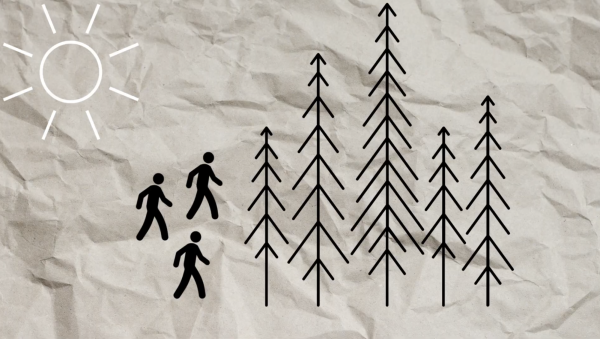Is the Fashion Industry Destroying the Environment?
March 19, 2020
Every day, you hear about the effects plastic waste and fossil fuels have on the environment. Tremendous changes have been made, such as switching from plastic to paper straws and introducing more electric cars, in order to save our dying planet. However, what many people fail to understand is that the fashion industry is one of the most harmful industries, and it is quickly destroying the planet one item of clothing at a time.
The idea of fast fashion is defined as buying more clothes for a cheaper price and disposing of them quicker. People have stopped rewearing clothes after a season and instead buy new ones for a low cost. Trends are constantly changing and what was once “in” during June is no longer “in” during December. Major companies have even started producing five, ten, or even fifteen collections per year instead of the traditional two to four. Brands including Forever 21, Zara, and H&M are some of the biggest offenders of fast fashion. It is estimated that clothing production has roughly doubled in the past twenty years and does not seem to be stopping soon.
Researchers from the United Nations Environment Programme have found that a garbage truck full of clothes is burned or dumped every second. These statistics are shocking, yet not many people seem to know about this issue.
Ms. Goodrich, a chemistry and environmental science teacher at Pentucket, referred to this global problem as an “invisible issue” to most people. She went on to explain how most people care about how they look and dressing nice. They are more focused on what brand or label they’re wearing, which often leads them to overlook the negative effects that a brand has on the environment.
Goodrich then explained how she believes the solution to fast fashion becomes “a matter of spending a little bit more for a quality item that lasts you a little bit longer instead of flipping over your wardrobe every season.” This may mean avoiding buying some of your favorite brands that are destructive to the environment.
This is where the idea of sustainable and eco-friendly fashion comes into play. A survey conducted at Pentucket found that 57 percent of students would avoid buying from a brand that they know has a negative impact on the environment. 32 percent of students said that they would consider avoiding these brands. This survey also found that 66 percent of students would be willing to pay more for a sustainable and eco-friendly item of clothing versus paying less for a cheaper and lower quality brand.
A student, who wished to remain anonymous, said, “I feel like I am in the middle here. Of course I want to help the environment and buy sustainable clothes that prove better quality. However, sometimes it comes down to a matter of cost. I do not always have the budget for higher end items.” Budget is an issue that a lot of teenagers may encounter.
Other students explained, “I would rather put my money towards a brand that is better for the environment rather than pay to harm it” and “It will last longer and have a better quality. Also, if it’s eco-friendly, it will be very nice to have made a small difference.”
Some people are fully against the idea of sustainable fashion. An anonymous student explained, “clothing is expensive as is. If it still looks good and costs less I am going to prefer it” and “Companies should make the environment a priority over making more money. Consumers shouldn’t have to compromise. Instead, companies should face the consequences for unethical production.”
There are two large problems at hand. The first one being the negative effect the fashion industry has on the environment. The second is not enough people are educated on this issue. Then, it comes down to whether or not people want to find a solution.
Even though this is an intimidating global issue, there are still some ways you can make a difference.
Thrifting
Thrifting is a great way to buy some of your favorite brands for cheap. You can still find good quality and name brand items at a thrift store. Plus, you are saving money and helping the environment.
Upcycling
If the idea of buying old clothes is not for you, upcycling is a great alternative. Upcycling is the process of repurposing or redesigning any clothes you may already own or ones that you have purchased.
Reading labels
Labels of clothing items can tell you a lot. Make sure you check where the item is manufactured and what type of material is used. Materials like organic cotton, cashmere, and linen are all eco-friendly materials.
Researching ethical and environment friendly brands
If you’re willing to spend more money on clothes, look for brands that are sustainable, environmentally friendly, and manufactured in ethical ways. Some ways to find out if a brand is ethical is to read their website and check for information about the factories. Checking where the clothes are produced, or any certifications the brand may have can help to expose the background of the company. Avoid supporting unethical brands like Romwe, Shein, and Forever 21. Brands like Romwe, Shein, and Forever 21 are some of the biggest offenders of fast fashion. These brands are mass producing items of clothing and selling them for $4-10 per item.












Jillian Colbert • Jun 14, 2020 at 12:32 pm
Lizzie, I think this article is well written and definitely a unique topic. You have brought an issue that is often overlooked to light, and given some helpful and attainable solutions. I enjoyed the interview comments from students, as they show perspective on how people feel on the issue of fast-fashion. I enjoyed reading your article, and found it very interesting.
Jillian Colbert • Jun 14, 2020 at 12:30 pm
Lizzie, I think this article is very well written and definitely a unique topic. You have brought an issue that is often overlooked to light, and given some helpful solutions. I enjoyed the interview comments from students, as they show perspective on how people feel on the issue of fast-fashion.
Hannah Linehan • Jun 10, 2020 at 12:06 pm
Lizzie, this article focuses on a very important topic and your writing has definitely done it justice. You have done a nice job of both bringing attention to the dangers of fast fashion and providing solutions on how to make a difference. Conducting surveys with students and interviewing an environmental science teacher were both great ideas and these groups of people make perfect sense to provide valid inputs on the topic. Great read!!